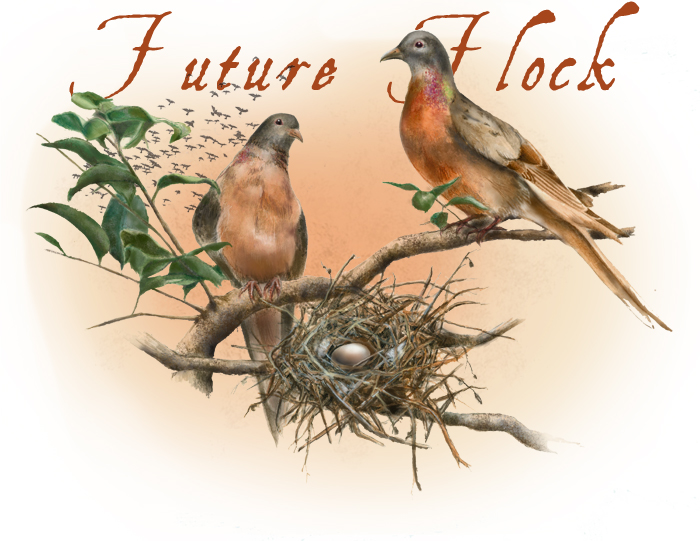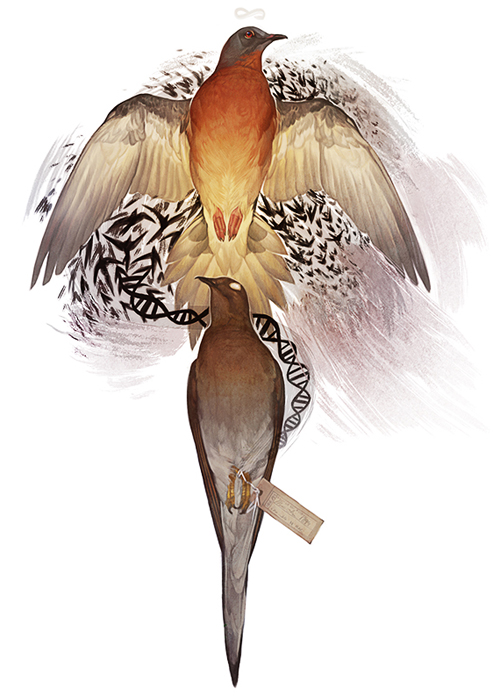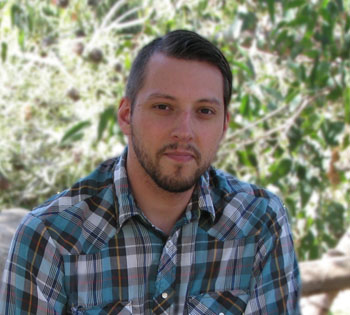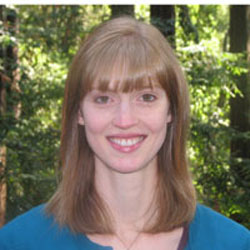
|
| Illustration:Jessica Hsiung |
Will genomic science help the iconic passenger pigeon return from extinction? Kelly Servick investigates. Illustrated by Jessica Hsiung and Justine Hirten.
Twelve birds lie belly-up in a wooden drawer. Bloated with stuffing, their ruddy brown chests resemble a row of sweet potatoes. Slate blue heads and thin white tails protrude in perfect alignment, except for one bird that cranes its neck to face its neighbor. A pea-sized bulge of white cotton sits where its eye should be. A slip of paper tied to its foot reads, “Ectopistes migratorius. Manitoba. 1884.” This is the passenger pigeon, a species that went extinct nearly a century ago.
About 1,500 passenger pigeons inhabit collections like this one at the Berkeley Museum of Vertebrate Zoology. They are all that’s left of a population of three billion. The passenger pigeon was the most abundant land bird in North America, and the species was perceived as a limitless resource. It was shipped in boxcars by the tons, sold as meat for 31 cents per dozen, and plucked for mattress feathers. But in 25 years, its population shrank from billions to thousands as commercial hunters decimated nesting flocks. Martha, the last living bird, took her place under museum glass in 1914.
Ben Novak doesn’t believe the story should end there. The 26-year-old genetics student is convinced that new technology can bring the passenger pigeon back to life. “This whole idea that extinction is forever is just nonsense,” he says. Novak spent the last five years working to decipher the bird’s genes, and now he has put his graduate studies on hold to pursue what started as his junior high school science project: de-extinction.
Novak is not alone. An organization called Revive and Restore is enlisting the support of preeminent scientists — and even National Geographic — to investigate putting the passenger pigeon back in the sky. The group has chosen Novak to spearhead the project.
The technical challenges are immense, the ethical questions treacherous. But as genetic technology advances, a scenario that’s hard to imagine is becoming harder to dismiss out of hand.
Bringing down the bird
When the bird from the Berkeley drawer flew over Manitoba in 1884, it didn’t travel alone. Passenger pigeons were named for their passage up and down eastern North America in flocks several hundred million strong. To sustain long, strenuous flights, the birds scarfed their way through the forest and left destruction in their wake. Ornithologist J.M. Wheaton described one flock as a rolling cylinder filled with leaves and grass. “The noise was deafening and the sight confusing to the mind,” he wrote in 1882. It was easy to tell where the pigeons had roosted: the trees were crippled, their branches cracked off and picked clean of nuts and acorns. For miles, the ground was coated with a layer of feces more than an inch thick.
But the same flocking behavior that made the bird destructive also made it vulnerable. Its nesting sites in the northeastern U.S. were densely packed — as many as 100 nests per tree, each containing a single egg. “They have this ecology that’s a bit like a sea turtle and a locust mixed together,” says Novak. Like hordes of baby turtles wiggling toward the ocean, pigeon hatchlings were a smorgasbord for predators. Each helpless lump of fat, as heavy as its parents but lacking their aerial skill, would wallow in the nest for a day or two, then flutter to the ground. Abandoned by their parents, the clueless cohort eventually would join the next flock migrating overhead.

Illustration: Justine Hirten |
|
|
Even before Europeans arrived, hunters shot nests with arrows or knocked them down with poles. But in the mid 19th century, the railroad and the telegraph turned the pigeon into a national commodity. Professional trackers followed flocks, descended on nest sites and shipped pigeon meat to the commercial hub of New York. Their tactics were brutal: Firing into the trees brought down thousands of birds in one afternoon. Setting a match to the combustible birch bark forced terrified chicks to fling themselves from their nests. By the late 1850s, flocks were shrinking. Several states passed laws prohibiting hunting near nest sites, but these measures came too late. By 1889, the population was in the thousands.
Novak remembers learning about the pigeon in school. “I just fell in love with the story of it,” he says, “this absolutely bigger-than-life story of the most abundant bird on the planet going extinct so quickly.” While teachers discussed what he calls “‘save the panda’ kind of stuff,” Novak wondered about species that had already been lost. He wasn’t convinced that animals like the passenger pigeon were gone forever. “I don’t know,” he says, “I thought that was too absolute.”
What went wrong?
For population ecologists, even reckless hunting tactics didn’t explain how the passenger pigeon dropped off the map so quickly.
The survival strategy of the species was to offer predators like raptors and rodents more pigeons than they could shove in their mouths, says David Blockstein, a biologist with the National Council for Science and the Environment. But once hunters targeted nest sites, the dwindling flocks grew more vulnerable to predation. “It doesn’t take a population biologist to figure out what happens if you shut off the major means of nesting for a species for a decade,” he says.
Big questions remain about the pigeon’s past: How did it become so abundant in the first place? When did its decline begin, and at what point was it doomed to fail? Evolutionary biologist Beth Shapiro of UC Santa Cruz approaches these questions through paleogenomics, the study of ancient DNA to learn about extinct populations.
Just as scientists construct an evolutionary tree to show the common ancestor of different species, they can also make a tree for a single gene within a population. They can estimate how long ago two variations of the gene arose from a mutation, then find the probability that two individuals shared a common ancestor in the previous generation. “That probability changes depending on whether the population is growing or shrinking,” says Shapiro.
In 2004, Shapiro and her colleagues first used this approach to analyze fossils of extinct bison around the Bering Strait. They showed that the population started decreasing 35,000 years ago, before humans — the previous suspects in the decline — reached the area. Shapiro hopes to use the same technique to map the rise and fall of the passenger pigeon.

Photo: Kelly Servick |
Ben Novak of the Revive and Restore project, on the UC Santa Cruz campus. |
|
|
Ben Novak followed these ancient DNA studies as a student at Montana State University. He studied ecology and evolution with the hope of bringing back extinct animals, but his focus soon shifted toward more modest population studies. “You’re steered away from the science fiction when you go to school,” he says. “But the whole idea of bringing the species back was what really got me in love with the concept I was now studying.” When he started graduate school at McMaster University in Ontario, he hoped to analyze genes from the bird that had captivated him as a kid. All he needed were samples from a museum specimen.
The great leap backward
The Manitoban pigeon lying in its drawer at Berkeley holds a vast library in its feet. Every cell in its fleshy toe pads contains chromosomes that spell out the bird’s identity, from the color of its eggs to the sound of its voice. Pigeon DNA is a sequence of four building blocks, or bases, and is 1.5 billion bases long. The Human Genome Project that revealed our own 3 billion bases in 2003 used a process called Sanger sequencing: cut the DNA into fragments, then label their ends with fluorescent tags to figure out the location of each base. A computer reassembled the fragments by finding places where they overlapped.
Applying the same method to DNA from pigeon toe pads would be a nightmare. Like the birds from which it is extracted, this DNA has seen better days. It has been broken apart by enzymes and oxygen, zapped with ultraviolet radiation and contaminated by other organisms. “Whenever you touch it, your DNA gets in the sample,” says Shapiro. “If it sits next to other birds, their DNA gets in the sample.”
But in the last decade, a set of techniques known as next-generation sequencing has offered a better way to work with less-than-perfect DNA. New machines can analyze hundreds of thousands of short fragments at the same time, speeding up the tedious sequencing process and bringing down its cost. “In the past 10 years, sequencing has gotten about 500,000 times more efficient,” says biostatistician Steven Salzberg of Johns Hopkins University. “Nothing in the history of civilization or technology has ever gotten that much more efficient that fast.”
Using next-generation sequencing, scientists identified the passenger pigeon’s closest living relative: Patagioenas fasciata, the ubiquitous band-tailed pigeon of the American West. This was an important step. The short, mangled DNA fragments from passenger pigeons don’t overlap enough for a computer to reassemble them, but the band-tailed pigeon genome could serve as a scaffold. Mapping passenger fragments onto the band-tailed sequence would suggest their original order.
Eager to crack the pigeon’s genome, Novak sent requests to 30 different museums for a toe fragment, and was rejected by all of them. He resigned himself to a thesis focusing on mastodons, but he continued pigeon research on the side. In 2011, Chicago’s Field Museum of Natural History offered him a sample. He sent the pigeon DNA to a Toronto lab for sequencing, using $2,500 he borrowed from a friend.
A revival scheme
Meanwhile, others were taking note of the revolution in biotechnology, including writer and activist Stewart Brand, best known for a late-1960s counter-culture publication called the Whole Earth Catalog. He is founder and president of the nonprofit Long Now Foundation. Brand saw reversing extinction as a conservation method of the future. He and his wife, Ryan Phelan, founder of the consumer genomics company DNA Direct, created a branch of the Long Now Foundation called Revive and Restore. They chose the passenger pigeon as the first experiment.
Revive and Restore hosted a meeting at Harvard University in February 2012. Attendees included experts like Beth Shapiro, David Blockstein, and renowned Harvard molecular geneticist George Church. Shapiro was skeptical of the project’s goal from the start, but she decided to add her expertise — and her concerns — to the conversation.
When Novak heard about the meeting, he contacted Church, Phelan and Brand to see if he could contribute. “Stewart and I both looked at the note and went, ‘Wow. This is interesting. Let’s learn more about Ben Novak,’” Phelan recalls. Novak was invited to coordinate the project as a Revive and Restore employee, and he abandoned his graduate program.
At an October 2012 follow-up meeting at National Geographic, Novak connected with genomic scientists and began formulating a step-by-step vision of de-extinction. His official title, according to the organization’s website, was “passenger pigeon reviver.”
A bird in the lab
When Novak describes his revival scenario, his eyes shine with enthusiasm, but his tone is that of a matter-of-fact classroom lecture. With a wry smile, he presents de-extinction as if the science already were the stuff of textbooks.
Here is Novak’s plan: Sequence the band-tailed and passenger pigeon genomes and find the significant differences between them. Edit the DNA from a band-tailed pigeon germ cell — the type that develops into sperm or eggs — to match that of the passenger pigeon. Implant this cell into the egg of another pigeon, perhaps a rock pigeon, which is easy to work with in the lab. Hope that the germ cell will migrate into the gonads of the developing chick. Allow the chick to grow up, and breed two such birds to create a passenger pigeon.
 Sequencing the two genomes is within reach. In March 2013, Novak joined Shapiro in her lab at UC Santa Cruz; he hopes to finish both genomes in about a year. But the project already has a major snag. Because the last common ancestor of the two species flew about 30 million years ago, their genomes will likely differ at millions of locations, Shapiro says. Scientists will have to figure out which variations correspond to meaningful physical differences. “It’s not impossible,” she says, “it’s just a [lot] of work.” Even in humans, mapping traits to genes is a murky discipline. Sequencing the two genomes is within reach. In March 2013, Novak joined Shapiro in her lab at UC Santa Cruz; he hopes to finish both genomes in about a year. But the project already has a major snag. Because the last common ancestor of the two species flew about 30 million years ago, their genomes will likely differ at millions of locations, Shapiro says. Scientists will have to figure out which variations correspond to meaningful physical differences. “It’s not impossible,” she says, “it’s just a [lot] of work.” Even in humans, mapping traits to genes is a murky discipline.
According to Steven Salzberg, that’s not even the biggest barrier. Modifying the genome of one species to match another would be an unprecedented feat of engineering. The most promising method comes from Church’s lab, where a technology called Multiplex Automated Genome Engineering has made fine-scale alterations to bacterial genomes. Novak hopes Church can make similar modifications along the band-tailed pigeon chromosome. But Salzberg cautions that animal genomes are much more complicated than bacterial ones.
Getting from a strand of passenger pigeon DNA to a living bird is the last big step. Novak will need specialized germ cells, which scientists know how to extract from chicken embryos, but not pigeons. He is investigating a work-around: extracting stem cells from band-tailed pigeons instead, and stimulating them to become germ cells. This feat has never been achieved in birds. However, Novak says, “Someone could make a major breakthrough in next two years.”
A final nesting place
All the technical challenges are only phase one of Revive and Restore’s plan. “It’s not a science project,” says Phelan, “it’s a conservation project. It’s really about ecological enrichment.” Novak plans to set up a sanctuary of lab-generated pigeon chicks in the bird’s original breeding territory. He would then train homing pigeons to pass over the nest site, showing the chicks their ancestral migration route. Novak says passenger pigeons would restore balance to forest ecosystems, clearing brush and fertilizing soil.
This strategy doesn’t make sense to Blockstein, who says “quote-unquote” before every mention of de-extinction. He doubts any small population could survive long enough to reach its original numbers. If it did, he fears the bird would become a pest to farmers, consuming commercial berries and grain. Stanford University bioethicist Hank Greely shares this concern. “You’re re-introducing to the same geographic region,” he says, “but not to the same environment.”
No governing body exists to make decisions about re-introducing an extinct species. Once the science is within reach, Novak says he will work with wildlife management authorities to set up a legal framework.
Beyond the ecological risks, Revive and Restore has a bigger “why” question to answer. The argument that extinction is forever underlies important protections like the Endangered Species Act, says Greely. Why try to rewrite the passenger pigeon’s iconic cautionary tale?
The accelerating pace of biotechnology is one answer, Phelan says. If an organized effort like Revive and Restore tackles a high-profile and tightly controlled project, it might bring scientists and the public into an important conversation. All the genomic tools to carry out de-extinction may soon be available to students and amateurs, Phelan believes. “It’s time for society to actually think through how to do it responsibly,” she says.
Even Shapiro, who is no de-extinctionist, defends the value of an ambitious goal that unifies scientific disciplines. On March 15, 2013, she joined a lineup of scientists at the National Geographic headquarters in Washington, D.C. for TEDx DeExtinction. In a day-long series of talks, Revive and Restore shared a vision of de-extinction with the public.
“I’m thrilled to be along for the ride,” Shapiro says. “I will do what I can to bring some enthusiasm and hopefully also some sanity to the problem.”
In Novak’s mind, reviving the pigeon is not just about turning back the clock, but also demonstrating the exhilarating pace of science. “It’s going to get people more interested in the idea of conservation, because of how cool it is,” Novak says. Greely concurs that “a sense of wonder” is one of the most compelling cases for de-extinction.
If Novak can convince public and potential funding sources of that value, the passenger pigeon might do more than ride a wave of new technology; it might propel science forward. Whether we ever see another living passenger pigeon, its genetic code remains alive. The birds in their dark museum drawers may be more powerful now than when they swarmed by the billions.
Editor's note: A version of this story appeared online at Wired.com on March 15, 2013.
Story ©2013 by Kelly Servick. For reproduction requests, contact the Science Communication Program office.
Top
Biographies
 Kelly Servick Kelly Servick
B.A. (cognitive science and comparative literature) University of Georgia
Internship: Science (Washington, D.C.)
I’ve always loved scavenger hunts. As a kid, I’d plant slips of paper throughout the house leading to a prize—or just to my hiding place, where I’d pop out and startle my unsuspecting hunter.
College felt a bit like a scavenger hunt for the right career, with cryptic clues hidden in textbooks and lectures. They diverted me from my English major and led me into the lab. But clues to my future were muffled by noisy EEG channels and a humming fMRI machine.
During my Americorps service at a Virginia state park, I designed a scavenger hunt to trick vacationing kids into learning about ecology. I loved organizing knowledge into a suspenseful journey. Now, by writing about science, I can map a route through complex research, leading my reader to something intriguing and unexpected.
Kelly Servick web site
. . . . . . . . . . . . . . . . . . . . . . . . . . . . . . . . . . . . . . . . . . . . . . . . . . .
 Jessica Hsiung Jessica Hsiung
B.A. (art history, biology and visual studies) University of Toronto
Internships: Royal Ontario Museum (Toronto); Smithsonian National Museum of Natural History (Washington, D.C.)
As is the case with many science illustrators, I enjoy both art and science and I'm ecstatic to be able to draw and paint my favorite natural subjects. I love all kinds of animals, and creating personalities and characters for them (even if mostly in my head) through my illustrations makes it incredibly fun and rewarding for me!
Jessica Hsiung web site
. . . . . . . . . . . . . . . . . . . . . . . . . . . . . . . . . . . . . . . . . . . . . . . . . . .
 Justine Hirten Justine Hirten
B.F.A. (painting) The School of the Art Institute of Chicago
Internship: Cornell Lab of Ornithology (Bartels Science Illustration Intern)
While working as an avian rehabilitator and caretaker, I have been using science illustration to merge my love of art and wildlife. I strive to create iconic statement illustrations that present the animals' idiosyncrasies while maintaining scientific accuracy.
Justine Hirten web site
Top |

